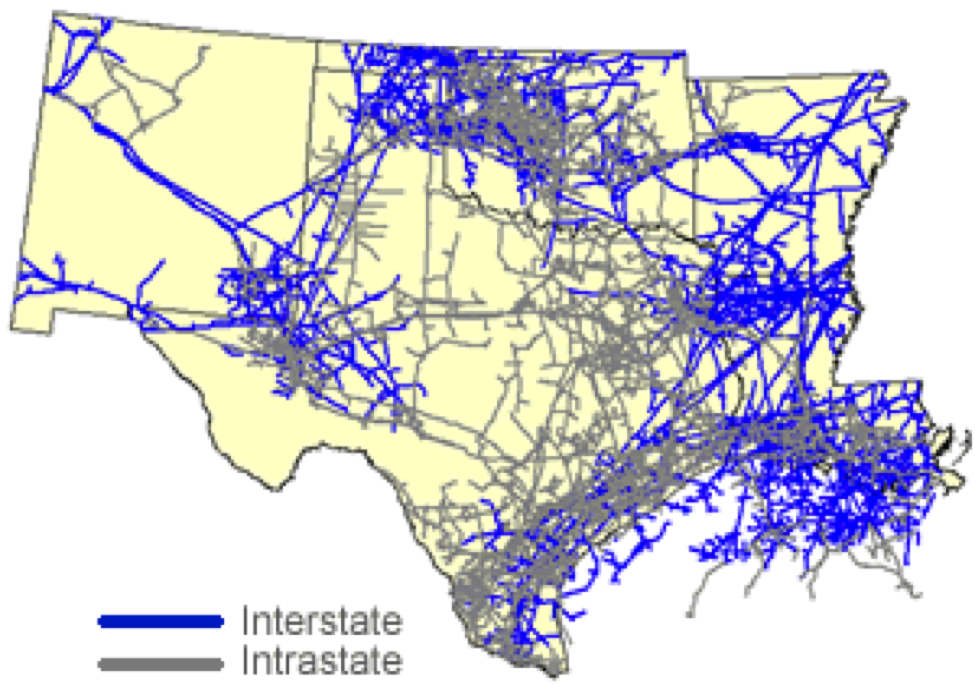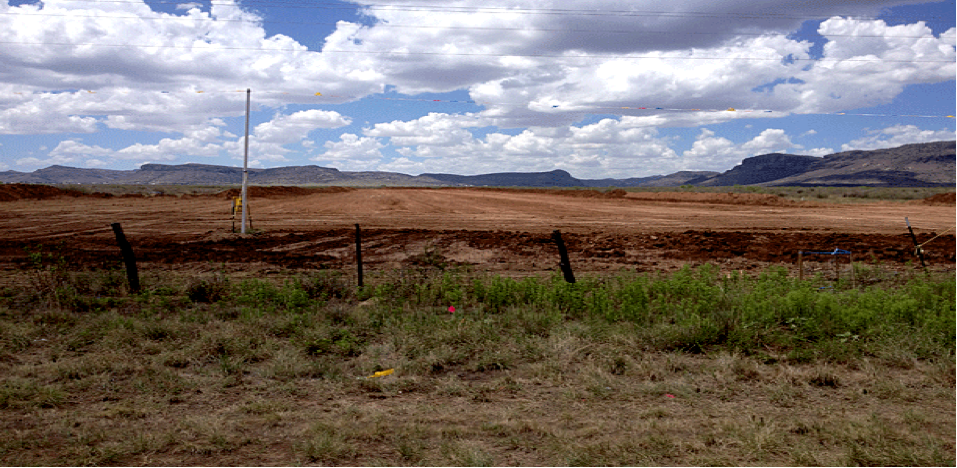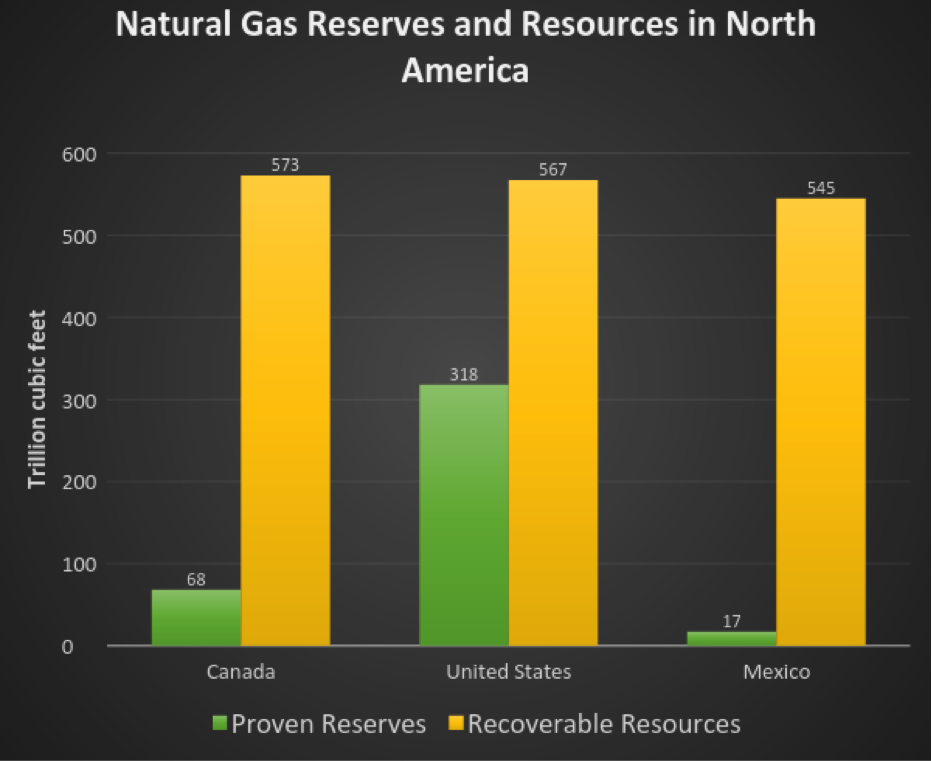By Mark Black
There are 210 natural gas pipeline systems consisting of 305,000 miles of transmission pipe in the U.S. Sixty-six of these systems with 56,000 miles of intrastate pipe are found in the Southwest Region of the U.S. (“Natural gas pipeline network - transporting natural gas in the United States,” 2008) (Figure 1). There are no natural gas pipelines in the 12,313 square miles of the Big Bend Region of west Texas, yet (Bureau, 2016). Numerous environmental and health concerns have been voiced in opposition to the proposed Trans-Pecos Pipeline (TPPL) by various organizations. The 143 miles of 42-inch diameter highly pressurized pipe carrying extremely volatile fracked gas through a desert grassland is justifiably a concern to residents of the area. However, not everyone affected by the pipeline opposes it. Energy Transfer Partners, L.P. (ETP), the company primarily responsible for the development of the TPPL, has offered monetary incentives and propaganda to convince the local public that the TPPL is beneficial to society and environmentally friendly. The campaign for complacency has apparently succeeded.

Figure 1: Southwest Region Natural Gas Pipeline Network. (U.S. Energy Information Administration. 2008.)
Problems with Pipelines
The Big Bend Conservation Alliance lists a multitude of concerns pertaining to the construction and operation of natural gas pipelines. Environmental impacts from the 125-foot wide by 3-foot deep easement include habitat disturbance of native flora and disruption of ephemeral desert streams (Figure 2). Wildlife fragmentation and habitat loss will result from the development of additional infrastructure in the form of roads with increased heavy truck traffic, fences, block valves, meters, and compression stations. Air, noise, and light pollution from compression stations is considerable as methane, benzene, toluene, sulfuric oxide, and formaldehyde are released into the atmosphere at regular intervals (“Concerns,” 2016).

Figure 2: TPPL construction, August 5, 2016. Facing west from Hwy 118 towards Sunny Glen subdivision of Alpine, Texas. (John Waters, Gazette, 2016)
Soil erosion and contamination of water sources is always a concern with buried pipelines. An estimated 500 million to 1.5 billion gallons of water will be wasted during the construction and testing of the pipeline. As the quality of the environment degrades, the eco-tourism industry in the area diminishes. The Big Bend Region is seismically active, increasing the chances of subterranean pipeline failure, resulting in leaks and potential explosions (“Concerns,” 2016). When questioned about the safety of natural gas pipelines, Kelcy Warren, CEO and Chairman of ETP, answered, “Accidents do happen.” Mr. Warren goes on to merrily state that, “In the last decade, companies like Exxon have done a good job at convincing the American public that (natural gas) is a clean, efficient, abundant product” (Service, 2016).
Convincing the Public
Public complacency regarding the protection of the environment enables projects like the TPPL to succeed. The mere offering of monetary incentives by companies like ETP not only garners support for the project, but it persuades others who may not have much of a position on the issue to ignore the true consequences of the devastation that will ensue. ETP estimates $1.9 million per year in tax benefits will be awarded to Presidio County, Marfa, and Presidio school districts, and hospital district. However, these speculative figures have not been verified by the Presidio County Appraisal District and are subject to the fluctuating markets of the oil and gas industry. Similarly, in Brewster County, an ETP estimation of a $400,000 net infusion of funds into the Alpine ISD is purely speculative and could end up being much less as the instabilities of market trends are realized. Superintendent Dennis McEntire is convinced that the Presidio ISD will ultimately benefit from the economic development associated with the TPPL (“Truck traffic for Marfa, tax revenue for area school districts, officials say of pipeline « big bend now,” 2015).
There are a number of people that have been persuaded to believe that the TPPL will be delivering natural gas to Mexico due to a shortage in the country. In actuality, the U.S. Energy Information Administration (EIA) reported that Mexico has just about as much technically recoverable shale gas resources as that of Canada and the U.S. (Figure 3). Economics prevent Mexico from recovering natural gas from their resources. It is simply cheaper to buy it from the U.S.

Figure 3: Estimated proved natural gas reserves compared to unproved wet shale gas technically recoverable resources in the top three oil and gas producing countries of North America. (U.S. Energy Information Administration. 2013.)
Natural gas has been touted by the oil and gas industry as being abundant and clean. However, the extraction process of hydraulic fracturing, or fracking, required to obtain this “abundant” resource is highly toxic to the environment as well as being a serious safety and health concern (2016, 2016). Fracking involves the high-pressure injection of large amounts of water and extremely poisonous chemicals into shale to separate and access minerals and gas, creating a favorable condition water table contamination. Also, the name “natural gas” in itself is propaganda. It is actually CH4, or methane, a highly powerful greenhouse gas that is estimated to be more than 80 times more potent than carbon dioxide. Large quantities of methane gas are emitted into the atmosphere during every stage of natural gas production and distribution (“Clean burning natural gas for Mexico?,” 2016).
The proclamation by ETP that the TPPL will replace the air polluting practices of coal and wood burning in Mexico by delivering “clean” burning natural gas is unfounded. There is no evidence to suggest that Mexico plans to convert these power production practices to natural gas. In fact, the entity responsible for coal burning operations, which generates a mere 4% of energy in Mexico, the Comisión Federal de Electricidad (CFE), is currently expanding and modernizing coal-fired power plants and storage facilities. The renewable, low emission sources of agricultural waste products derived from wood and wood fiber account for less than 1% of Mexico’s energy production. Furthermore, the rural communities that burn actual wood for heat and cooking will not have access to natural gas as the cost of infrastructure needed to transport it is prohibitive (“Clean burning natural gas for Mexico?,” 2016).
No one can deny the global economic significance of fossil fuel, as most of the human population depends on it in some form. Sacrificing ecological values and risking environmental degradation for capital gains and investor profits does not have to be accepted as inevitable. The people of communities affected by such travesty are made to feel powerless, ultimately becoming complacent as a result. Health and safety concerns regarding pipelines may exist in perpetuity, but the magnitude eventually fades with time and false reassurances. The more one is led to believe in the rhetoric presented by pipeline companies, the less willing one is to protest. There are many additional concerns and questions surrounding the construction and operation of the TPPL not discussed here. The ramifications of the precedent set by allowing the oil and gas industry to operate in the Big Bend area are of paramount importance to the protection and preservation of this unique and original ecoregion.
Mark Black is a senior at Sul Ross University. His hometown is Alpine, Texas.
References
2016, S. C. (2016, July 8). The Trans-Pecos pipeline: Myths Texas oil and gas want you to swallow. Retrieved August 8, 2016, from http://www.sierraclub.org/texas/big-bend/trans-pecos-pipeline-myths-texas-oil-and-gas-want-you-swallow
(2016, 2016)
Bureau, U. C. (2016, August 10). Census.Gov. Retrieved August 10, 2016, from https://www.census.gov/
(Bureau, 2016)
Clean burning natural gas for Mexico? (2016). Retrieved August 10, 2016, from http://www.bigbendconservationalliance.org/notcleanburningnaturalgasformexico/
(“Clean burning natural gas for Mexico?,” 2016)
Concerns. (2016). Retrieved August 6, 2016, from http://www.bigbendconservationalliance.org/trans-pecos-pipeline/concerns/
(“Concerns,” 2016)
Gazette, T. B. B. (2016, August 5). Pipeline construction started near Alpine — confirmed by TPP. Retrieved August 10, 2016, from http://bigbendgazette.com/2016/08/05/pipeline-construction-started-near-alpine/
(Gazette, 2016)
Natural gas pipeline network - transporting natural gas in the United States. Retrieved August 9, 2016, from https://www.eia.gov/pub/oil_gas/natural_gas/analysis_publications/ngpipeline/index.html
(“Natural gas pipeline network - transporting natural gas in the United States,” 2008)
Service, P. B. (2016). Watch now: CEO | Kelcy warren, energy transfer partners | KERA Video Retrieved from http://video.kera.org/video/2365194202/
(Service, 2016)
Truck traffic for Marfa, tax revenue for area school districts, officials say of pipeline « big bend now. Retrieved August 6, 2016, from http://bigbendnow.com/2015/06/truck-traffic-for-marfa-tax-revenue-for-area-school-districts-officials-say-of-pipeline/
(“Truck traffic for Marfa, tax revenue for area school districts, officials say of pipeline « big bend now,” 2015)
. Retrieved From http://www.eia.gov/analysis/studies/worldshalegas/pdf/fullreport.pdf
(U.S. Energy Information Administration. 2013.)